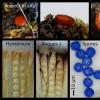
15-12-2025 15:48
 Danny Newman
Danny Newman
Melanospora cf. lagenaria on old, rotting, fallen

15-12-2025 15:54
 Johan Boonefaes
Johan Boonefaes
Unknown anamorph found on the ground in coastal sa

15-12-2025 21:11
 Hardware Tony
Hardware Tony
Small clavate hairs, negative croziers and IKI bb

15-12-2025 07:09
 Danny Newman
Danny Newman
indet. Rutstroemiaceae sp. on unk. fallen leavesMc

15-12-2025 07:05
 Danny Newman
Danny Newman
Pseudosclerococcum golindoi (det: Zotto)near Cosb

15-12-2025 11:49
 Danny Newman
Danny Newman
ITS sequences from the following two collections B

15-12-2025 12:34
 Danny Newman
Danny Newman
indet. Rhytismataceae on oak leafnear Purchase Roa

09-12-2025 12:06
 Andgelo Mombert
Andgelo Mombert
Bonjour,Je recherche l'article concernant Hypobryo
 Bonsoir le forum,
Bonsoir le forum,J'ai récolté dernièrement des Scutellinia à spores rondes que je pense être S. minor ou S. barlae. Les spores subglobuleuses et l'ornementation quelque peu hétérogène me font pencher pour S. minor. Qu'en pensez-vous ?
L'aspect général est typique du genre Scutellinia. Brièvement, apothécie < 1 cm, d'un bel orange uniforme, à marge un peu plus claire. Surface externe couverte de poils courts.
Spores subglobuleuses (Q = 1.1), (15) 17 +/- 0.87 (19) x (14) 15 +/- 1.1 (18) µm [(min) moyenne +/- écart-type (max), N = 14, mesures effectuées dans le bleu coton lactique, ornementation exclue], à verrues arrondies grossièrement homogènes (quelques-unes plus grosses) de (1.2) 1.5 +/- 0.1 (1.6) µm. Asques octosporés, inertes dans l'iode. Paraphyses cylindriques, cloisonnées, légèrement renflées au sommet, remplies d'un pigment orange qui se colore en violet dans le réactif de Melzer. Boucles présentes. Poils à paroi épaisse, jusqu'à 300 µm, à base simple ou bifurquée (jamais multiple).
Lieu de récolte : Baisse de la Plate, 2600 m, Alpes-Maritimes (France), en terrain schisteux. Zone humide, au milieu des mousses.
Cordialement,
Edouard


Thanks for the link. It helps a lot! I summarize as follows:
- S. barlae has globose spores, while those of S. minor are subglobose.
- The boreoalpine distribution of S. minor is compatible with my collection.
- One discrepancy though: my collection does not have many bifurcate hairs.
I will consider getting an ITS sequence for this collection.
Best wishes,
Edouard

regarding the supposed boreoalpine distribution of S. minor - I'm aware that both Schumacher and Matocec listed it as such. However, both Sphaerospora minor and its synonym Sc. subglobispora were described from rather warm areas of the Czech Republic and certainly not higher then some 500-600 m a.s.l. I have even collected it in 220 m a.s.l., ash-poplar-oak forest near Olomouc. Also the collections known in neighbour Slovakia are mostly from colline and submontane level. In these two countries at least it doesn't seem to be restricted to high altitudes, unlike e.g. S. pilatii or S. mirabilis.
Might be interesting to compare sequences of colline vs. alpine collections. But I don't know which genes are useful in this genus.
Viktorie


